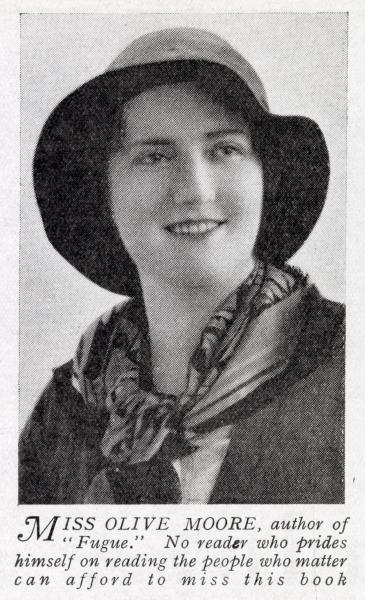Olive Moore
Olive Moore
Born:
Hereford, United Kingdom
Died:
Haywards Heath, United Kingdom
Gender:
Occupation:
Biography
Authored By: Erin Kingsley
Edited By: N/A
Olive Moore is a mystery. She first appears on the literary record in the 1920s as a journalist, penning at least 37 articles forthe Daily Sketch, a British tabloid, from 1923 to 1934. Also in 1923, we know she wrote at least two articles for John O’London’s Weekly, a literary magazine (Dickinson, “(R)Evolution” 91), and pieces for the Sunday Pictoral (Cavey, “Olive Moore”). This journalistic work appears under her birthname, Constance Vaughan. She then assumed her pseudonym, Olive Moore, which she would employ until the end of her life. She chose this appellation because her writing was an “acquired taste, dry and sophisticated,” and would necessarily leave her readers wanting more (Moore 424, quoting Alec Bristow). As Olive Moore, she published three novels and a disjointed collection of aphorisms and observations in the late 1920s and early 1930s to considerable acclaim before disappearing. (Only in 2016 was her trail found again.) She does not have a biography, and there is only one extant published monograph analyzing her works: Female Embodiment and Subjectivity in the Modernist Novel by Renée Dickinson. The few scholars devoted to Moore continue to explore the riddle of her life and career in hopes that more will be revealed about this talented and enigmatic writer.
As Moore’s shrouded life continues to be uncovered, distinct errors in the record must be amended. For example, Olive Moore was long assumed to be the penname of Constance Edith Vaughan, born in Hereford in 1904. However, new research by Sophie Cavey reveals that Olive Moore was actually born Miriam Constance Beaumont Vaughan in Hereford in 1901. Her father was Charles Beaumont Vaughan, an actor, and her mother was Miriam Leah Freedberg, most likely a stage actress who used the stage name “Miriam Lewes.” Nothing more is known of Moore’s early life, aside from sparse details she shares in a biographical entry published in Authors Today and Yesterday (1933), reprinted as an Appendix to the 1992 edition of Dalkey Archive Press’ Collected Writings. Moore writes that she was sent to convent school at the age of 5, and studied “art in Italy,” and “literature and language, at the Sorbonne” (Moore 421).
In 1924, Moore married Sava Botzaris (also known as “Botzaritch”); Moore’s occupation is listed as a “dancing instructor” on their marriage certificate. Botzaris was a talented artist and sculptor, a true child of modernity: born in Serbia, immigrated to London in 1920, then relocated to Venezuela in 1941. His bust of Moore appears as the cover image of Collected Writings and of Dalkey Archive Press’ Spleen (1996). Moore and Botzaris reportedly had one son in 1925, Peter David Beaumont Botzaritch; their grandchildren claim Peter was adopted by another couple soon after his birth (Dickinson, “(R)Evolution” 91). Moore lived on 87 Doughty Street in Bloomsbury in the early 1930s, and she separated from Botzaris during this decade. Divorce proceedings with Botzaris began around 1942, and were not finalized until at least 1949 (Cavey, Creativity 225). We also know Moore was connected to Charles Lahr’s Red Lion Street Circle in Holborn Street, a neighborhood adjacent to Bloomsbury. Lahr and his group were known to be anarchists, revolutionaries, and working-class upstarts who positioned themselves as orthogonal to the more refined Bloomsbury Group.
Moore’s first novel, the slim Celestial Seraglio, appeared in 1929. A bildungsroman of European schoolgirls attending a convent school in Belgium, the novel was “largely autobiographical” and the character Mavis was “very much a self-portrait” (Moore 423, quoting Bristow). The novel is punctuated by holy “meditations” of Sister Marie in French while the mystery of sex and puberty is augmented by horrific stories of martyrs, mishaps, cruel punishments, and disfigured bodies.
Next came the novel Spleen in 1930 (published as Repentance at Leisure in the United States). Spleen relates the fragmented story of Ruth, an English woman who flees her landed husband after giving birth to a disabled son, spending the rest of her life in self-imposed exile on the fictional island of Foria, Italy (most likely based on the town of Forio, on the Italian island of Ischia). Spleen has garnered the most critical attention and features one of the earliest scenes of subjective, detailed childbirth in a modernist novel, as well as a disabled character, giving rise to incisive scholarship by Maren Linett, Matt Franks, and Jane Garrity. Moore recounts that during a trip to New York (November 1929 – May 1930), her hotel burned down, and the original manuscript of Spleen was lost (Moore 421). She was forced to re-write the novel from memory, an “unhappy and deadly experience” (Moore 421).
Moore published the novel Fugue in 1932, featuring another ambivalent maternal character, Miss Lavinia Reede, pregnant and following her departed lover, Harrion, through Alsace. Like Ruth in Spleen, Lavinia struggles with forming a connection with her son and cuts all ties with him even after spending several tender months together. Despite the many strong contemporary reviews Fugue garnered—for example, in 1932, Jane Southron insists that Fugue “is, without doubt, one of the most beautifully written novels of this decade” (48)—critical attention paid to Fugue thus far has been scant.
In 1933, Charles Lahr’s Blue Moon Press published Moore’s limited edition, 99-run essay on D.H. Lawrence, entitled Further Reflections on the Death of a Porcupine (reprinted in The Apple is Bitten Again). In this brief essay, Moore considers Lawrence’s posthumous literary reputation, praising his talent as a “creative artist” and claiming, among other things, that Lawrence “will take his place as one of the finest imaginative prose writers in English letters” (Moore 401).
In 1934, Moore debuted The Apple is Bitten Again, a puzzling collection of acerbic fragments she published after becoming “sick and tired of being quoted and plagiarized without acknowledgement” (Moore 336). The work is divided into numbered “Notebooks” that serve as chapters, with sections demarcated by italicized phrases such as: “Formation of Self” or “Grammar verses Poetry” or even “Disposing of the body” (Moore 344). The title of the work alludes to the importance of man not fighting his natural “Conscious-Intelligent movements,” what Moore deems the “Local Brain,” but instead learning from the perfect systems of Nature, such as grass and the apple (Moore 404). Apple repeatedly lambastes women, especially “the failure of women as creative artists” (388), society, the family, London, city life, modernity, manufacturing, and female writers, including Virginia Woolf, Rebecca West, Katherine Mansfield, and even Sappho, whom Moore finds “pedestrian” (388).
By the early 1930s, Moore’s reputation as a British writer was growing. She was included in the 1933 edition of Authors Today and Yesterday, which contained biographical sketches of notable authors of the day (Cavey, Creativity 2). Stanley Kunitz, editor of Twentieth Century Authors (previously Authors Today and Yesterday) reported in 1942 that Moore was working on a book, Amazon and Hero: The Drama of the Greek War for Independence, although no trace of this book has ever been found (Cavey, Creativity 3). Cavey suggests that the book was most likely “a historical account or fictionalized narrative of the Greek War (1821-1832),” inspired by the Greco-Serbian Botzaris (Cavey, Creativity 4).
After publishing Apple, Moore disappeared from the British literary scene. Contemporary literary scholars long assumed that Moore’s publication activities had ceased with Apple. However, Cavey recently discovered Moore writing for Scope: Magazine for Industry, a publication which touted “commercial and scientific innovation” as the best manner to speed post-war recovery (Cavey, Creativity 5). From 1942 until the magazine’s dissolution in 1959, Moore was its “guiding force,” writing virtually the entire publication, including a regular “Man of the Month” column in which she interviewed an “eclectic mix” of powerful men in Britain (Cavey, Creativity 4-5). Moore became romantically involved with Scope’s editor, John M. Ryan, living with him and taking the name “Mrs. Olive Ryan” (Cavey, Creativity 4). Additionally, Moore wrote for other publications owned by Creative Journals during these years, such as Shelf Appeal and Persuasion (Cavey, “Olive Moore”). After the dissolution of her relationship with Ryan, Moore moved to Bolnore, Sussex, living with her friend Janet Lobban, the former art editor at Scope, until Moore’s death at age 78 (Cavey, Creativity 4).
Very little archival material exists for Moore, a writer “notorious not for her talent but for her absence” (Cavey, Creativity 5). A handful of letters and the sole surviving holograph manuscript of Moore’s oeuvre, that of Fugue, exist in the Charles Lahr Archives, Senate House, University of London. The unsolved mysteries of her biographical life aside, Moore remains a remarkably unique figure in modernism. A 1992 review of Moore’s Collected Works in the Chicago Tribune proclaims Moore to be a “formidable and curiously misogynistic” woman who “writes like an avenging angel” and is “far more talented” than Katherine Mansfield (Coates). More recently, Dickinson categorizes Moore’s writing as a fusion of the “textual experimentation” of Virginia Woolf and Djuna Barnes with the “literary and spiritual tradition” of T.S. Eliot and Ezra Pound (Dickinson, Female Embodiment 75). While Moore was undoubtedly a figure of “astonishing contradictions” (Prose), these inconsistencies should not deter scholars from studying her writing. Moore’s acerbic and cutting wit is unmatched in modernist texts, and her oeuvre is worthy of further scrutiny.
Further Reading:
Cavey, Sophie. ‘Fire From Olympus, Apples From Eden’: Creativity and Dissent in the Work of Olive Moore. University of Southampton (UK), Doctoral Thesis, 2018. https://eprints.soton.ac.uk/432575/
Works Cited
Cavey, Sophie. ‘Fire From Olympus, Apples From Eden’: Creativity and Dissent in the Work of Olive Moore. Unpublished dissertation, University of Southampton, 2018.
Cavey, Sophie. “Olive Moore: A New Biography.” Forthcoming in Feminist Modernist Studies.
Coates, Joseph. “A ‘Fiercely Focused’ Writer, Rediscovered.” The Chicago Tribune, 14 June 1992, https://www.chicagotribune.com/news/ct-xpm-1992-06-14-9202220864-story.html.
Dickinson, Renée. Female Embodiment and Subjectivity in the Modernist Novel: The Corporeum of Virginia Woolf and Olive Moore. Routledge, 2009.
Dickinson, Renée. “The (R)Evolution of Olive Moore.” Essays on Music and Language in Modernist Literature. Ed. Catherine O’Callaghan. Routledge, 2018. pp. 79-93.
Franks, Matt. “Mental Inversion, Modernist Aesthetics, and Disability Exceptionalism in Olive Moore’s Spleen.” Journal of Modern Literature, vol. 38, no.1, Oct. 2014, pp. 107-127.
Garrity, Jane. “Olive Moore’s Headless Woman.” Modern Fiction Studies, vol. 59, no. 2, Summer 2013, pp. 288-316.
Linett, Maren. Bodies of Modernism: Physical Disability in Transatlantic Modernist Literature. University of Michigan Press, 2017.
Moore, Olive. Collected Writings. Dalkey Archive Press, 1992.
Prose, Francine. “The Short, Brilliant Career of Olive Moore.” The Washington Post, 26 Apr. 1992, https://www.washingtonpost.com/archive/entertainment/books/1992/04/26/the-short-brilliant-career-of-olive-moore/c0e903db-3df6-45ad-abdc-8f37fe76a939/.
Southron, Jane. “Olive Moore’s ‘Fugue’ and Some Other Recent Works of Fiction.” The New York Times 25 Sept 1932, pp. 48.
Bibliography
Bibliography:
Articles and columns in various publications, including Daily Sketch, John O’London’s Weekly, Sunday Pictoral, Scope: Magazine for Industry, Shelf Appeal, and Persuasion.
Moore, Olive. Celestial Seraglio. Collected Writings. London: Jarrolds Publishers, 1929.
Moore, Olive. Fugue. London: Jarrolds Publishers, 1932.
Moore, Olive. Further Reflections on the Death of a Porcupine. London: Blue Moon Press, 1933.
Moore, Olive. Spleen. London: Jarrolds Publishers, 1930.
Moore, Olive. The Apple is Bitten Again. London: Wishart, 1934.

